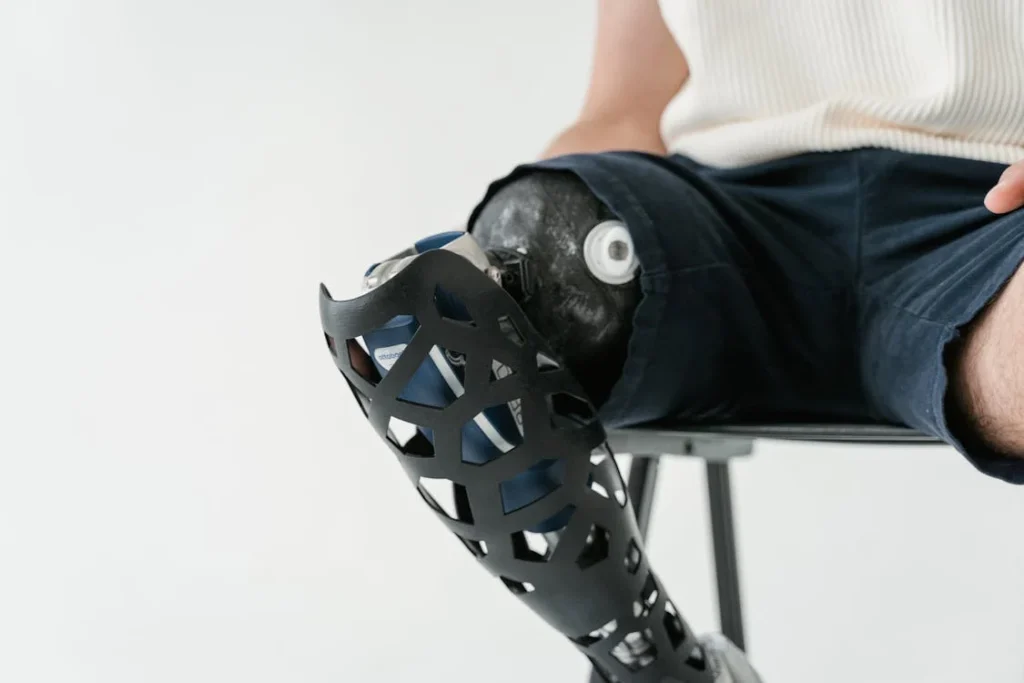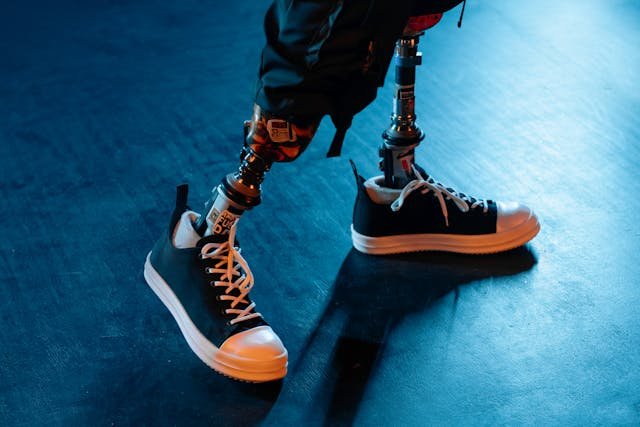Exploring the great outdoors is a freeing and exciting experience. The feeling of climbing a trail, walking through forests, or standing on a mountaintop is something that every adventurer understands. But if you use a prosthetic limb, you know that hiking and outdoor activities come with unique challenges. Uneven terrain, changing weather, and long hours of walking require a prosthetic foot that is strong, stable, and comfortable.
Luckily, modern prosthetic feet are designed to help you take on these challenges. Whether you love hiking, trekking, or just enjoying nature walks, the right prosthetic foot can make a huge difference. It needs to provide good grip, absorb shocks, and adjust to different surfaces so you can move naturally and safely.

What to Look for in a Prosthetic Foot for Hiking and Outdoor Adventures
Hiking is different from walking on smooth pavements. The ground can be uneven, steep, slippery, or rocky, which means your prosthetic foot must handle these conditions without causing discomfort or instability.
Choosing the right prosthetic foot for outdoor adventures requires careful consideration of several key factors.
Strong and Durable Materials
Hiking puts extra stress on a prosthetic foot, so durability is essential. The foot should be made from high-strength materials like carbon fiber or titanium, which are both lightweight and tough.
A strong foot will withstand constant impact, rough surfaces, and changes in temperature without wearing down quickly. If the foot is too weak, it may crack or lose its effectiveness over time, making it unsafe for long hikes.
Good Shock Absorption for Comfort
Walking on uneven terrain can be hard on your residual limb, especially when stepping on rocks, tree roots, or downhill slopes. A prosthetic foot with excellent shock absorption can reduce stress on your joints and prevent pain during long hikes.
Some models have built-in cushioning or hydraulic mechanisms that help absorb impact, making walking feel more natural. This reduces fatigue and allows you to hike longer without discomfort.
Stability on Uneven Terrain
One of the biggest challenges of hiking with a prosthetic foot is maintaining balance on unpredictable surfaces. A good prosthetic foot for hiking should have a flexible and adaptive sole that adjusts to different angles.
Some feet have multi-axial movement, which allows them to tilt and adapt to sloped surfaces. This feature improves grip and prevents slipping, giving you more confidence while hiking.
Water and Dirt Resistance
Outdoor environments expose prosthetic limbs to mud, rain, sand, and dust. If your prosthetic foot is not designed for these conditions, dirt can get stuck in the joints, reducing movement and flexibility.
A water-resistant or waterproof prosthetic foot is ideal for hiking because it won’t be damaged by moisture. Additionally, a dirt-resistant design prevents buildup that could interfere with normal function.
Lightweight for Long Distances
Carrying extra weight while hiking can slow you down and increase fatigue. A prosthetic foot should be lightweight yet strong enough to handle the demands of outdoor terrain.
Carbon fiber is a great choice because it combines durability with a lightweight feel. A lighter foot means you’ll use less energy with each step, allowing you to cover more distance without tiring quickly.
Traction and Grip for Safety
Slipping on wet rocks, loose gravel, or muddy trails is a risk for any hiker, but it can be especially dangerous for prosthetic users. A hiking prosthetic foot should have a non-slip sole with good traction to provide a secure grip on different surfaces.
Some advanced models have tread patterns similar to hiking boots, which help improve stability on challenging trails.
Compatibility with Different Footwear
Hiking requires proper footwear, and your prosthetic foot should be able to fit into different types of hiking shoes or boots. Some prosthetic feet have adjustable heel heights, allowing you to switch between different types of footwear for different terrains.
This flexibility is useful if you need extra ankle support for rugged trails or prefer lighter shoes for easier walks.
Energy Return for Efficiency
Walking on a trail requires more effort than walking on a smooth surface. A prosthetic foot with energy-return technology helps store and release energy with each step, making movement more efficient.
This reduces strain on your muscles and helps you maintain a natural walking rhythm. Carbon fiber feet are known for their excellent energy return, making them a top choice for active individuals.

Top Prosthetic Feet for Hiking and Outdoor Adventures
Finding the right prosthetic foot for hiking is crucial for both comfort and performance. Not all prosthetic feet are designed to handle the challenges of outdoor terrain, but some models stand out for their durability, flexibility, and adaptability.
Here are some of the best prosthetic feet for hiking and outdoor activities, designed to help users move confidently on rough and uneven surfaces.
Össur Vari-Flex XC
The Össur Vari-Flex XC is a high-performance prosthetic foot built for active individuals who enjoy outdoor adventures. Its carbon fiber design provides excellent energy return, making each step feel natural and efficient.
The foot is flexible enough to adapt to uneven surfaces while remaining stable on rugged terrain. It also has a split-toe design, which improves balance by allowing the foot to adjust to different ground angles.
This prosthetic foot is ideal for hikers who cover long distances and need a foot that can handle impact without causing strain. The Vari-Flex XC also has a smooth rollover effect, which makes walking feel fluid and reduces fatigue.
Freedom Innovations Highlander
The Highlander by Freedom Innovations is designed for extreme conditions, making it one of the best choices for hikers and outdoor enthusiasts.
It is made from high-strength carbon fiber, allowing it to handle heavy impact and long treks. The Highlander is known for its excellent shock absorption, which helps reduce strain on the residual limb and lower back during long hikes.
One of its standout features is its multi-axial movement, which allows the foot to adjust to sloped surfaces, rocks, and uneven trails. This improves stability and reduces the risk of slipping or losing balance on challenging hikes.
Blatchford Echelon
The Blatchford Echelon is a prosthetic foot designed with advanced hydraulic ankle technology. This makes it a great choice for hikers because it automatically adjusts to slopes and different terrains, providing a more natural walking experience.
The hydraulic ankle helps maintain proper alignment, reducing stress on the knees and hips, which is important for long-distance hiking.
Another key advantage of the Echelon foot is its water-resistant design, which allows users to confidently hike in wet conditions without worrying about damage from moisture or mud.
Fillauer AllPro
The Fillauer AllPro is a versatile prosthetic foot designed for both everyday use and outdoor activities. Its carbon fiber construction provides a high level of energy return, making walking and hiking feel more effortless.
The foot is built to handle the demands of outdoor terrain, with excellent flexibility that adapts to different surfaces.
One of the best features of the AllPro is its ability to provide a smooth and comfortable gait, even on uneven ground. This makes it an excellent choice for users who want a combination of durability, responsiveness, and comfort while exploring nature.
College Park Terrain
The College Park Terrain foot is specifically built for outdoor enthusiasts who need a prosthetic foot that can handle rugged conditions. It features a multi-axial design that allows for natural movement on sloped and rocky trails.
The foot also has an aggressive tread pattern on the sole, similar to a hiking boot, which improves grip and prevents slipping on wet or loose surfaces.
Another advantage of the Terrain foot is its water resistance, which allows hikers to cross streams or hike in rainy weather without worrying about damage. Its high durability makes it a reliable option for users who frequently explore challenging environments.
Ottobock Triton Vertical Shock
The Ottobock Triton Vertical Shock is an excellent prosthetic foot for high-impact activities like hiking. It is designed to absorb vertical forces, which helps reduce pressure on the residual limb when walking on uneven or rocky trails.
This feature is especially useful for hikers who cover long distances or frequently encounter steep inclines.
The Triton Vertical Shock also has a responsive energy-return system, making each step feel smooth and efficient. Its flexible sole provides excellent adaptability, allowing users to move comfortably across different types of terrain.

How to Choose the Right Prosthetic Foot for Your Hiking Needs
Selecting the best prosthetic foot for hiking depends on several personal factors. Everyone’s needs are different, and what works for one person might not be the best fit for another.
When choosing the right prosthetic foot for outdoor adventures, consider your activity level, hiking environment, and comfort requirements.
Understanding Your Activity Level
Before selecting a prosthetic foot, consider how often and how intensely you plan to hike. If you enjoy occasional nature walks on well-maintained trails, you may not need a highly specialized hiking foot.
A general-purpose foot with good flexibility and shock absorption might be enough.
However, if you are a serious hiker who takes on rugged mountain trails, steep inclines, or multi-day treks, you need a high-performance prosthetic foot.
Feet with energy return technology, waterproof designs, and multi-axial movement will provide the best support for advanced hiking.
Matching Your Foot to the Terrain
The type of hiking you do also affects your choice. If you prefer trails with smooth paths and slight inclines, a foot with moderate flexibility and a comfortable walking motion will work well.
But if you hike in forests, mountains, or rocky environments, you’ll need a prosthetic foot that provides excellent grip, adaptability, and durability.
For those who enjoy hiking in wet conditions, such as crossing streams or trekking in the rain, choosing a water-resistant or waterproof prosthetic foot is important. Wet conditions can cause slipping, so a foot with an aggressive tread pattern is useful for extra traction.
Prioritizing Comfort and Fit
Hiking can be physically demanding, so your prosthetic foot must be comfortable for long periods. A poor fit can cause blisters, pressure sores, and joint pain.
If your residual limb changes shape due to weather or activity, consider a foot with adjustable features or an adaptable socket system.
A prosthetic foot that absorbs shock effectively can prevent strain on your knee, hip, and lower back. If you frequently experience discomfort after hiking, switching to a foot with better impact reduction can make a big difference.
Considering Weight and Energy Efficiency
A heavy prosthetic foot can make hiking more tiring. Lightweight options, especially those made from carbon fiber, are ideal because they reduce the effort needed to walk long distances.
Some prosthetic feet also offer high energy return, meaning they store energy when you step and release it when you push off. This makes walking feel more natural and reduces overall fatigue.
Ensuring Compatibility with Prosthetic Components
Your prosthetic foot must work well with your entire limb system, including the socket, suspension, and pylon. Some advanced feet require specific knee or ankle joints for full functionality.
Before purchasing a hiking foot, consult your prosthetist to ensure compatibility with your existing setup.
Testing Different Options
If possible, try out different prosthetic feet before making a final decision. Many prosthetists offer trial periods where you can test how a foot performs in real-world conditions.
Walking on various terrains, testing uphill and downhill movements, and evaluating comfort levels can help determine the best choice for you.

How to Choose the Right Prosthetic Foot for Your Hiking Needs
With so many prosthetic feet available, choosing the right one for hiking and outdoor adventures can feel overwhelming.
However, selecting the best option comes down to understanding your personal needs, activity level, and the type of terrain you’ll be exploring. Here’s what to consider when making your decision.
Assess Your Hiking Style and Terrain
The type of hiking you do plays a big role in determining which prosthetic foot is right for you. If you enjoy short nature walks on well-maintained trails, a foot with basic flexibility and shock absorption may be enough.
However, if you love steep climbs, rocky paths, or unpredictable terrain, you’ll need a more advanced foot with multi-axial movement and strong traction.
For those who hike in different weather conditions, a water-resistant or waterproof prosthetic foot is essential. If you plan to cross rivers or hike in rainy areas, choosing a foot that won’t be damaged by moisture will ensure durability and performance.
Consider Your Activity Level
Your overall activity level should influence your choice of prosthetic foot. Some models are built for occasional outdoor adventures, while others are designed for high-intensity, frequent hiking.
If you’re someone who spends a lot of time outdoors and loves challenging hikes, investing in a high-performance prosthetic foot with excellent shock absorption and stability will make a significant difference.
For those who use a prosthetic for both daily life and hiking, a foot with a smooth transition between activities can be a great option.
Some prosthetic feet are versatile enough to function well in both urban and outdoor settings, eliminating the need to switch between different models.
Find the Right Balance Between Flexibility and Stability
A hiking prosthetic foot needs to offer a balance between flexibility and stability. Flexibility helps the foot adjust to uneven ground, making movement feel more natural.
However, too much flexibility without proper stability can make balancing difficult, especially on steep inclines or rocky paths.
Multi-axial feet are a great choice for hikers because they move in multiple directions, allowing for better adaptation to rough terrain. A foot with good ground contact will help prevent slips and falls, giving you more confidence while exploring.
Ensure Proper Fit and Comfort
Even the best prosthetic foot won’t be effective if it doesn’t fit correctly. A poorly fitting foot can cause discomfort, skin irritation, or pressure sores, making long hikes painful.
Working with a prosthetist to ensure the right socket fit, alignment, and suspension system will make hiking more enjoyable and pain-free.
If your residual limb size changes due to temperature, swelling, or muscle development, having an adjustable foot can help maintain comfort.
Some prosthetic feet allow for small changes in alignment and heel height, making it easier to switch between different types of footwear and terrain.
Consult Your Prosthetist
Choosing a prosthetic foot is a personal decision, and a prosthetist can provide valuable guidance based on your specific needs.
They can assess your walking style, residual limb condition, and activity goals to recommend the best option. They can also help with adjustments and maintenance, ensuring that your prosthetic foot remains in peak condition for hiking.

Tips for Hiking Comfortably with a Prosthetic Foot
Once you have the right prosthetic foot for hiking, the next step is making sure you stay comfortable and safe on the trails.
Hiking with a prosthetic limb requires some adjustments, but with the right approach, you can enjoy outdoor adventures without unnecessary discomfort or risk.
Break in Your Prosthetic Foot Before a Big Hike
Just like a new pair of hiking boots, a prosthetic foot needs some time to break in. Before heading out on a long or challenging hike, spend some time walking on different surfaces to get used to how your foot responds.
Try walking on gravel, dirt paths, slopes, and stairs to test its flexibility and grip. This will help you identify any adjustments needed before tackling more difficult trails.
Choose the Right Footwear for Stability and Comfort
Wearing proper hiking shoes or boots is just as important as having the right prosthetic foot. Your shoes should provide good ankle support, a strong grip, and enough cushioning to reduce impact on your residual limb.
Some prosthetic feet allow you to adjust the heel height, making it easier to switch between different types of hiking footwear.
If you are hiking in wet or muddy conditions, waterproof boots with a secure fit will help prevent slipping and keep your prosthetic foot clean. Breathable materials can also help reduce excessive sweating, keeping your limb dry and comfortable.
Pace Yourself and Take Breaks
Hiking with a prosthetic foot can be more tiring than hiking with natural limbs, especially on uneven terrain. Listen to your body and take breaks when needed.
Resting for a few minutes during your hike can help prevent fatigue and reduce stress on your prosthetic. Finding a comfortable rhythm that allows you to enjoy the trail without overexerting yourself is key.
Use Trekking Poles for Extra Support
Trekking poles can be a game-changer for hikers with prosthetic limbs. They provide extra balance and stability, especially on steep trails or uneven surfaces.
Using trekking poles can also help reduce the strain on your residual limb by distributing weight more evenly across your body. Adjustable poles are the best option since they allow you to change the height depending on the terrain.
Be Prepared for Environmental Challenges
Nature can be unpredictable, and being prepared will make your hiking experience smoother.
If you are hiking in hot weather, bring extra moisture-wicking socks or liners to stay dry and prevent irritation. In colder conditions, an insulated liner can help maintain a comfortable temperature for your residual limb.
If you know the trail will have water crossings, mud, or sand, be sure your prosthetic foot is resistant to dirt and moisture. Carrying a small towel or cloth to clean your foot after walking through wet areas can prevent buildup that may affect movement.
Check Your Prosthetic for Any Issues After the Hike
After a long hike, inspect your prosthetic foot for any signs of wear or damage. Look for loose screws, dirt buildup, or any unusual stiffness in movement. Cleaning your foot and ensuring all parts are in good condition will help maintain its performance for future adventures.

Maintaining Your Prosthetic Foot for Long-Term Use
A well-maintained prosthetic foot will last longer and perform better, especially for hiking and outdoor activities. Since trails expose prosthetic limbs to dirt, moisture, and impact, regular care is essential to prevent wear and tear.
Taking a few simple steps to keep your prosthetic in top condition will ensure that it remains reliable on every adventure.
Clean Your Prosthetic Foot After Every Hike
After a day on the trails, your prosthetic foot may have collected dust, mud, or small debris. Wiping it down with a damp cloth and mild soap will help remove dirt before it builds up and affects performance.
If your prosthetic foot is waterproof, rinsing it with clean water can remove fine sand or grit from hard-to-reach areas. Always make sure it is completely dry before using it again to prevent moisture damage.
Check for Loose Parts and Wear
Hiking puts stress on your prosthetic foot, especially on rough terrain. After each trip, inspect your foot for any loose screws, cracks, or stiffness in moving parts.
If you notice unusual noises, reduced flexibility, or any discomfort while walking, it may be a sign that adjustments or minor repairs are needed. Catching small issues early can prevent bigger problems and ensure your prosthetic foot stays in optimal condition.
Lubricate Moving Parts If Necessary
Some prosthetic feet, especially those with multi-axial movement, may require occasional lubrication to keep joints moving smoothly. If your foot starts to feel stiff or squeaks during movement, check with your prosthetist about using a recommended lubricant.
Avoid using household oils or greases, as these can attract dirt and cause buildup over time.
Store Your Prosthetic Foot Properly
When not in use, store your prosthetic foot in a clean, dry place away from direct sunlight and extreme temperatures. Avoid leaving it in a hot car or damp area, as excessive heat or moisture can weaken certain materials.
If you have multiple prosthetic feet for different activities, keeping them in a protective case can help prevent accidental damage.
Schedule Regular Check-Ups with Your Prosthetist
No matter how well you maintain your prosthetic foot, professional check-ups are important. Your prosthetist can assess its condition, make necessary adjustments, and suggest upgrades if needed.
If your hiking habits have changed or your residual limb has undergone any changes, a professional fitting will ensure that your prosthetic continues to perform at its best.
Conclusion
Hiking with a prosthetic foot is not just possible—it can be an incredible and fulfilling experience with the right equipment. Choosing a prosthetic foot designed for outdoor adventures will improve your stability, comfort, and endurance on the trails. Whether you need shock absorption for rocky paths, flexibility for uneven terrain, or waterproofing for wet conditions, the right prosthetic foot will help you move with confidence.
Maintaining your prosthetic foot is just as important as choosing the right one. Regular cleaning, inspections, and professional check-ups will ensure your foot stays in top condition for all your outdoor activities. Taking care of your residual limb with proper skin protection and pacing yourself on hikes will make every adventure more enjoyable.
Nature is meant to be explored, and with the right prosthetic foot, you can experience the freedom of hiking without limitations. Whether you’re taking a short nature walk or tackling a challenging mountain trail, your prosthetic foot should support your journey every step of the way.
Looking for expert advice on the best prosthetic foot for your hiking needs? Contact Robobionics today and take the first step toward your next great adventure!



